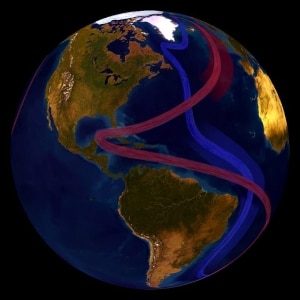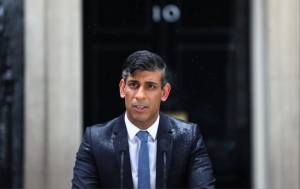What We are Quietly Losing in All the Tumult
Last week the ghouls of DOGE came to gut NOAA (National Oceanic and Atmospheric Administration) by firing all the probationary employees, because they were the easiest to fire. It was terrible, but it won’t be their last visit.
I wanted to take a moment to focus on this small and amazing agency because in all the chaotic headlines, outrageous speeches, and feral conduct, it’s easy to miss how consequential the Trumpist destruction of NOAA will be, if no one can stop it. Americans, and to a degree the whole world, depend on the nerdy, devoted folks at NOAA to kee p the fish biting, the crops abundant, the land peaceful, and their homes and businesses safe and dry.
p the fish biting, the crops abundant, the land peaceful, and their homes and businesses safe and dry.
I’ve often thought of them as some of the wonderful unsung heroes of the federal government. I learned about NOAA in college. We worked with their oceanography data, pulled down from a satellite to a 486 computer into our little marine science lab in 1993. All their data, then as now, was freely available to anyone in the world. Scientists, students, and even enthusiasts still dig into their archives all the time, and the people at NOAA often look for ways to make their data more useful to anyone who wants it. It has made life easier on this planet in uncountable little ways we’ll never know about.
I don’t want to focus on the most famous parts of NOAA, the National Weather Service and the National Hurricane Center, not because they’re not important. They are incredibly important: key to saving lives and property, and keeping people informed during emergencies. But these are the two parts of NOAA you most likely already know about. The National Weather Service is the best forecaster and weather analysis agency on this little blue marble we call home, and we see its work every time we look at local news and weather. NWS data populates the various apps on our phones, sends out warnings, and appears on our local news stations.
You also probably know about the National Hurricane Center. That’s the website and associated services that we turn to in hurricane season, to watch and wait to see the fates of the gulf states and the Eastern seaboard every year. It is the high drama of global weather. It attracts the news, storm chasers and media audiences.
Hurricane season, unlike tornadoes, storms, or the long slow violence of climate change, has a ready-for-TV narrative. The danger forms over the sea and creeps nearer and nearer to where people live, and no one is ever quite sure how it will turn out until the danger hits land. This part of weather forecasting even has its own mediagenic hero squad — the hurricane hunters who fly through the eye and eye wall of hurricanes in beefy planes, letting NOAA gather data that can’t be gathered any other way.
You probably know that NOAA has weather satellites. NOAA operates 18 satellites in total. Some track American and global weather, but they also track fires, desertification, drought, heat, tree cover, and more values besides — across the whole world.
But there’s so many more parts you may not know.
In the US, NOAA sent up around 76,000 weather balloons a year equipped with radiosondes, a instrument that gathers and transmits data for NWS upper air network, they’re creating a long term archive of weather, also gathering data that can’t be gathered with cameras in space. They’re even keeping track of cosmic rays as part of the radiosonde telemetry. In theory, that means the first signs of a cosmic event like a supernova could reach earth via NOAA first. Either way, their data is invaluable for many other federal agencies, as well as the public, and private businesses. But with the cuts that have already happened, not as many of those balloons are going up.
NOAA has always worked hand in glove with their more famous cousin, NASA. Though NOAA looks inward more than outward to space, as NASA does. Between the two of them, they run most of the USA’s non-military satellite and sensor systems, gathering data — but also making it public.
But in many ways, NOAA has more to do than NASA, or even many other more famous parts of the federal government.
So Much More Than A Weather Forecast
NOAA’s job is to keep you alive. We get this when it’s hurricanes, tornadoes, flash floods — that kind of thing. But they help the global system in so many more ways that are less obvious. NOAA’s satellite data plays an important role in precision agriculture, where farmers use satellite data and weather information to time and place their crops for the best possible yield. It’s good for the farmers, but also it’s good for the global food system, Data for farmers makes agriculture predictable and efficient, keeping prices low and cupboards stocked around the world. In a globalized food system, that means less political unrest, less war, and more healthy children.
 NOAA is the agency that monitors and studies El Niño, more precisely known at ENSO, which is a climate pattern in the equatorial Pacific ocean that affects much of global weather. This information is used all over the world to plan for crops, water allocation, typhoons, hurricanes and more. They study the AMOC,( Atlantic Meridional Overturning Circulation). This part of the global water circulation is of particular concern right now. If it fails (due to climate change) the Eastern Seaboard could drown and much of Europe could freeze. We don’t know how likely that is or what we could do about it, but NOAA is working the problem.
NOAA is the agency that monitors and studies El Niño, more precisely known at ENSO, which is a climate pattern in the equatorial Pacific ocean that affects much of global weather. This information is used all over the world to plan for crops, water allocation, typhoons, hurricanes and more. They study the AMOC,( Atlantic Meridional Overturning Circulation). This part of the global water circulation is of particular concern right now. If it fails (due to climate change) the Eastern Seaboard could drown and much of Europe could freeze. We don’t know how likely that is or what we could do about it, but NOAA is working the problem.
The NMFS (National Marine Fisheries Service) division of NOAA (pronounced “nymphs”) uses both ship and satellite surveys to monitor and protect fisheries, to keep them healthy and commercially viable. This is a global task, because fish don’t really care about your country’s EEZ (Exclusive Economic Zone) or other applicable human laws. NMFS tell people to stop fishing sometimes, and tell them where to fish at other times, using surveys, satellite data and other fisheries studies. This is about making sure that we can feed ourselves, and that the fish will be there next year, too. Fisheries management isn’t just a resource management task — it’s peace-building.
Fish and seafood account for 6.2% of the world’s protein consumption, and it’s often all the majority of protein in poor coastal communities. When fisheries are stressed or even collapse, conflict inevitably follows. Like increasing crop yields, protecting fisheries makes the world a little more peaceful. NOAA even monitors the Mississippi’s levels and behavior, safeguarding the cheapest and easiest trade route to the majority of the country. (the Mississippi is maintained by the Army Corp of Engineers, but this relationship between the agencies is just one of the many ways American infrastructure reaches out and finds the hand of NOAA there to help.)
NOAA is studying microplastics in whale guts, how to save coral reefs (and therefore also prevent another kind of fisheries collapse), saving sea turtles, and oyster bed restoration that could help preserve food and infrastructure on both of our coasts. They generate heat maps to help people survive the growing threat of dangerous heat events. They monitor the oceans to help enforce the Marine Mammal Protection Act, protecting cetaceans (along with other marine mammals) from habitat destruction and human interference.
 Even if you didn’t like whales, (and go get a therapist if that’s true, because who hates a whale?) they are a keystone species, and without them a lot of fisheries around the world would collapse. Whale poop is the great fertilizer of the global ocean. We know that, in part, because of NOAA research.
Even if you didn’t like whales, (and go get a therapist if that’s true, because who hates a whale?) they are a keystone species, and without them a lot of fisheries around the world would collapse. Whale poop is the great fertilizer of the global ocean. We know that, in part, because of NOAA research.
All of this, plus educational programs, ecological science, all your weather prediction, hurricane monitoring, and tornado warnings, for .11% of the federal budget. It’s one of the wonders of the data world. But the cost isn’t why DOGE and the Trumpists will want to destroy NOAA. There’s very little waste, fraud, and abuse here. There’s very few things that could even be mistaken for waste, fraud and abuse, even if you squinted as hard as you could.
What NOAA has is a truth the GOP doesn’t want anyone to see. NOAA is one of the foremost research agencies in the field of Climate Change. They collect much of the vital data, but also tell the story of anthropogenic climate change, well, and deeply, with receipts.
Here is NOAA’s mortal sin: their message is comprehensive, clear, and backed up with many, many studies. NOAA is easy to access for anyone in the world. This little slice of the federal government is telling on our crimes against nature, and the GOP doesn’t like that.
Without miraculous intervention, NOAA may be doomed in the coming weeks and months. I hope, and expect, that the people at NOAA are archiving its vast trove of potentially civilization-preserving records they’ve collected over the decades, to keep it from being destroyed by this insane GOP. I also hope companies and other governments will scoop up these people and get them back to their work — the work of preserving our comfortable Holocene civilizations on Planet Earth.
Science isn’t Transactional, and Data Doesn’t Make Deals.
Climate Change doesn’t care about the GOP’s political goals. This agency may end up dying for Trump’s insane vision of how the world works- and the damage is already arriving. There simply is no room in the Republican version of the world for forces beyond their control. But at this point, climate chaos is baked into the world as we have made it. Not all the might of the United States can win this fight with facts.
They have already fired the probationary workers, and anyone else who was legally vulnerable. The weather forecast part of NOAA’s mission is already being damaged. The Trump regime will be back to enact a political murder, trying to stop a global climate crisis by killing the messenger. But more fucking around has never made for less finding out, a fact that Trump will be demonstrating to us for years to come.









